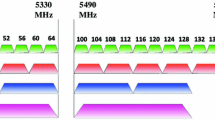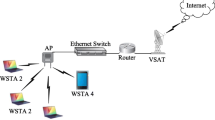Abstract
The enhanced distributed channel access (EDCA) mechanism has been adopted by both the IEEE 802.11e standard and the Multiband OFDM Alliance (MBOA) for quality of service (QoS) provisioning in high speed wireless LANs and UWB-based wireless PANs. Based on an analytical model of EDCA, this paper presents an optimal solution to providing maximum system throughput while maintaining the service differentiation among traffic classes. Contention window sizes are adapted to achieve throughput optimization according to the throughput ratio and number of active stations of each traffic class. To overcome the difficulty of accurate estimation of the number of competing stations we propose to use the method of subrange partitioning. An admission control scheme is also discussed. Simulation results demonstrate the effectiveness of the proposed MAC optimization framework.
Similar content being viewed by others
References
802.11e WG. (2003). Wireless medium access control (MAC) and physical layer (PHY) specifications: Medium access control (MAC) enhancements for quality of service (QoS). IEEE P802.11e/Draft 6.0, November 2003.
ECMA International. (2005). High rate ultra wideband PHY and MAC standard. ECMA-368, December 2005.
Gannoune, L., & Robert, S. (2004). Dynamic tuning of the contention window minimum (CWmin) for enhanced service differentiation in IEEE 802.11 wireless ad-hoc networks. In Proceedings of PIMRC, 2004.
Pang, Q. Liew, S., Lee, J., & Chan, S. (2004). A TCP-like adaptive contention window scheme for WLAN. In Proceedings of IEEE ICC, 2004.
Li, B., & Battiti, R. (2004). Achieving maximum throughput and service differentiation by enhancing the IEEE 802.11 MAC protocol. In Proceedings of WONS, 2004.
Hu, C., Kim, H., Hou, J., Chi, D., & Shankar, N. S. (2005). Provisioning quality controlled medium access in ultra wideband (UWB) WPANs. Technical report, Department of ECE, UIUC.
Bianchi G. (2000) Performance analysis of the IEEE 802.11 distributed coordination function. IEEE JSAC 18(3): 535–547
Zhao, J., Zhang, Q., Guo, Z., & Zhu, W. (2002). Throughput and QoS optimization in IEEE 802.11 WLAN. In Proceedings of 3G wireless, 2002.
Li, B., & Battiti, R. (2003). Performance analysis of an enhanced IEEE 802.11 distributed coordination function supporting service differentiation. In Proceedings of QOFIS, 2003.
Bianchi, G., & Tinnirello, I. (2003). Kalman filter estimation of the number of competing terminals in an IEEE 802.11 network. In IEEE INFOCOM, 2003.
Ma, H., Li, H., Zhang, P., Luo, S., Yuan, C., & Li, X. (2004). Range estimation and performance optimization for IEEE 802.11 based on filter. In Proceedings of IEEE WCNC, 2004.
Banchs, A., Perez, X., & Qiao, D. (2003). Providing throughput guarantees in IEEE 802.11e wireless LANs. In Proceedings of ITC 18, 2003.
Author information
Authors and Affiliations
Corresponding author
Rights and permissions
About this article
Cite this article
Fan, Z. Throughput and QoS optimization for EDCA-based IEEE 802.11 WLANs. Wireless Pers Commun 43, 1279–1290 (2007). https://doi.org/10.1007/s11277-007-9301-4
Received:
Accepted:
Published:
Issue Date:
DOI: https://doi.org/10.1007/s11277-007-9301-4




